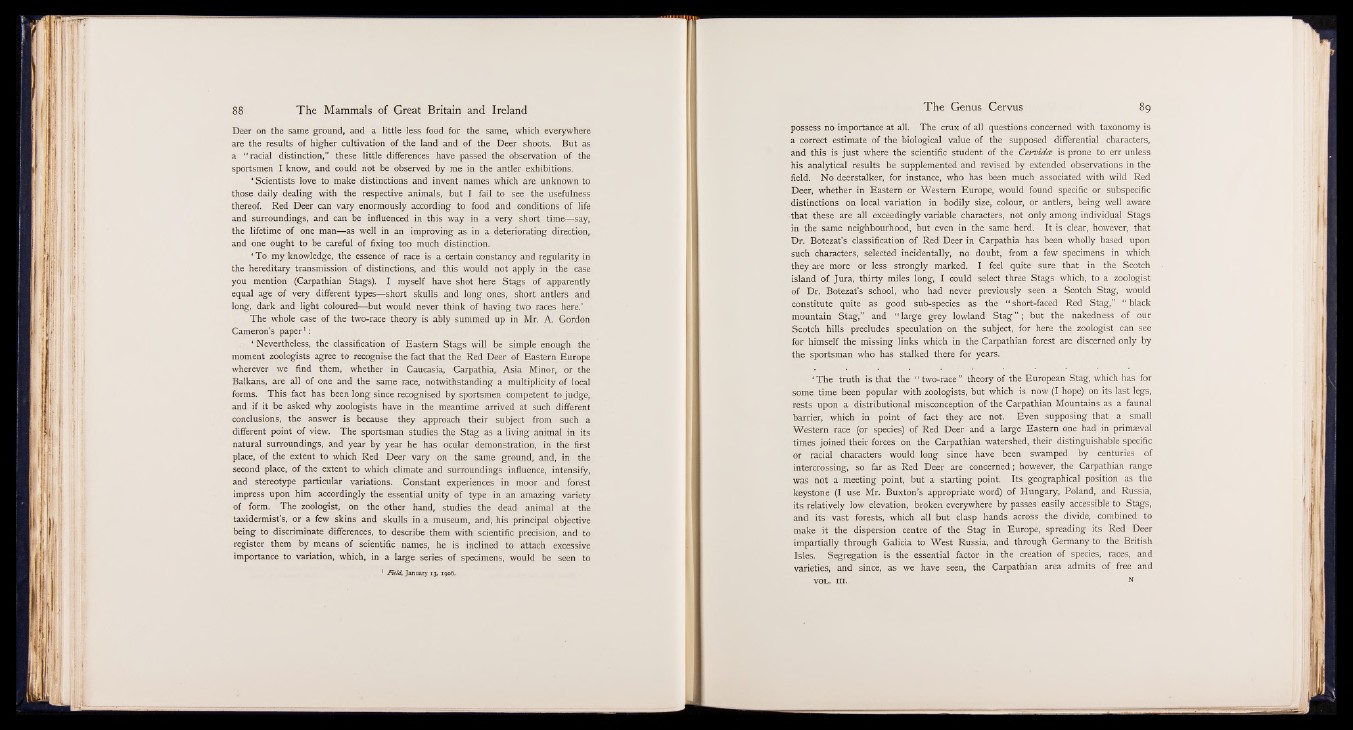
Deer on the same ground, and a little less food for the same, which everywhere
are the results of higher cultivation of the land and of the Deer shoots. But as
a “ racial distinction,” these little differences have passed the observation of the
sportsmen I know, and could not be observed by me in the antler exhibitions.
‘ Scientists love to make distinctions and invent names which are unknown to
those daily dealing with the respective animals, but I fail to see the usefulness
thereof. Red Deer can vary enormously according to food and conditions of life
and surroundings, and can be influenced in this way in a very short time— say,
the lifetime of one man— as well in an improving as in a deteriorating direction,
and one ought to be careful of fixing too much distinction.
‘ To my knowledge, the essence of race is a certain constancy and regularity in
the hereditary transmission of distinctions, and this would not apply in the case
you mention (Carpathian Stags). I myself have shot here Stags of apparently
equal age of very different types— short skulls and long ones, short antlers and
long, dark and light coloured— but would never think of having two races here.’
The whole case of the two-race theory is ably summed up in Mr. A. Gordon
Cameron’s paper1 :
‘ Nevertheless, the classification of Eastern Stags will be simple enough the
moment zoologists agree to recognise the fact that the Red Deer of Eastern Europe
wherever we find them, whether in Caucasia, Carpathia, Asia Minor, or the
Balkans, are all of one and the same race, notwithstanding a multiplicity of local
forms. This fact has been long since recognised by sportsmen competent to judge,
and if it be asked why zoologists have in the meantime arrived at such different
conclusions, the answer is because they approach their subject from such a
different point of view. The sportsman studies the Stag as a living animal in its
natural surroundings, and year by year he has ocular demonstration, in the first
place, of the extent to which Red Deer vary on the same ground, and, in the
second place, of the extent to which climate and surroundings influence, intensify,
and stereotype particular variations. Constant experiences in moor and forest
impress upon him accordingly the essential unity of type in an amazing variety
of form. The zoologist, on the other hand, studies the dead animal at the
taxidermist’s, or a few skins and skulls in a museum, and, his principal objective
being to discriminate differences, to describe them with scientific precision, and to
register them by means of scientific names, he is inclined to attach excessive
importance to variation, which, in a large series of specimens, would be seen to
Field, January 13, 1906.
possess no importance at all. The crux of all questions concerned with taxonomy is
a correct estimate of the biological value of the supposed differential characters,
and this is just where the scientific student of the Cervidce is prone to err unless
his analytical results be supplemented and revised by extended observations in the
field. No deerstalker, for instance, who has been much associated with wild Red
Deer, whether in Eastern or Western Europe, would found specific or subspecific
distinctions on local variation in bodily size, colour, or antlers, being well aware
that these are all exceedingly variable characters, not only among individual Stags
in the same neighbourhood, but even in the same herd. It is clear, however, that
Dr. Botezat’s classification of Red Deer in Carpathia has been wholly based upon
such characters, selected incidentally, no doubt, from a few specimens in which
they are more or less strongly marked. I feel quite sure that in the Scotch
island of Jura, thirty miles long, I could select three Stags which, to a zoologist
of Dr. Botezat’s school, who had never previously seen a Scotch Stag, would
constitute quite as good sub-species as the “ short-faced Red Stag,” “ black
mountain Stag,” and “ large grey lowland Stag ” ; but the nakedness of our
Scotch hills precludes speculation on the subject, for here the zoologist can see
for himself the missing links which in the Carpathian forest are discerned only by
the sportsman who has stalked there for years.
‘ The truth is that the “ two-race ” theory of the European Stag, which has for
some time been popular with zoologists, but which is now (I hope) on its last legs,
rests upon a distributional misconception of the Carpathian Mountains as a faunal
barrier, which in point of fact they are not. Even supposing that a small
Western race (or species) of Red Deer and a large Eastern one had in primaeval
times joined their forces on the Carpathian watershed, their distinguishable specific
or racial characters would long since have been swamped by centuries of
intercrossing, so far as Red Deer are concerned; however, the Carpathian range
was not a meeting point, but a starting point. Its geographical position as the
keystone (I use Mr. Buxton’s appropriate word) of Hungary, Poland, and Russia,
its relatively low elevation, broken everywhere by passes easily accessible to Stags,
and its vast forests, which all but clasp hands across the divide, combined to
make it the dispersion centre of the Stag in Europe, spreading its Red Deer
impartially through Galicia to West Russia, and through Germany to the British
Isles. Segregation is the essential factor in the creation of species, races, and
varieties, and since, as we have seen, the Carpathian area admits of free and
VOL. III.